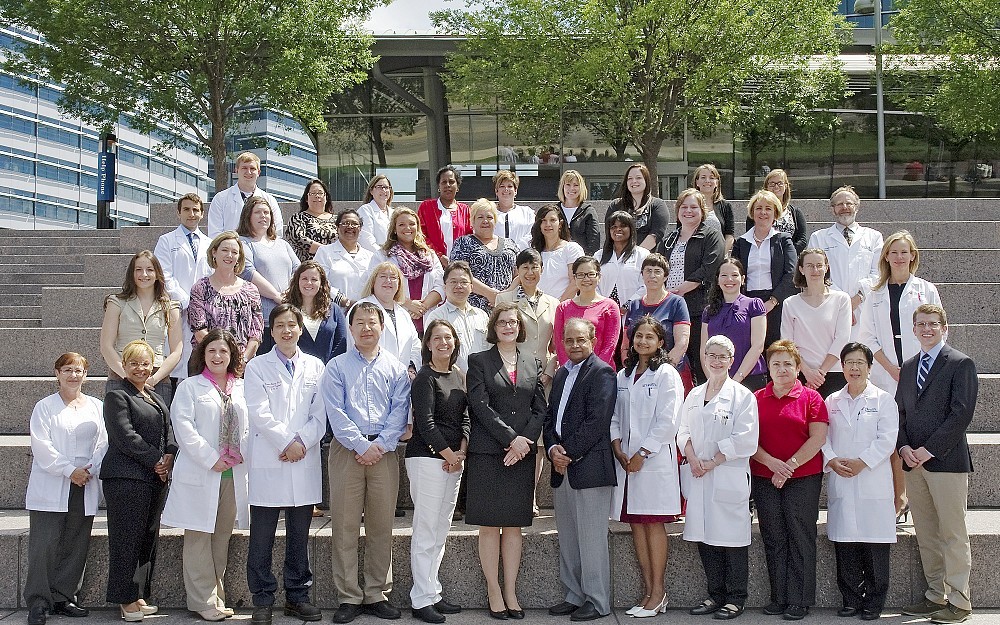
UC Cancer Institute Breast Center Reaccredited by National Program
The University of Cincinnati Cancer Institutes Comprehensive Breast Cancer Center has been reaccredited as a "Certified Quality Breast Center of Excellence in the National Quality Measures for Breast Centers (NQMBC) Programthe highest distinction for excellence given by the NQMBC.
The center first gained this recognition in 2013 and remains the only program in the city and Tristate area and only one of 18 centers nationally to gain this "Center of Excellence distinction.
"NQMBC is under the umbrella of the National Consortium of Breast Centers (NCBC), aimed at increasing the quality of breast health care provided by professionals to their patients, with 118 centers participating nationwide in the NQMBC program. Of those 118 centers, 51 are centers of excellence, and of those, only 18 are comprehensive centers of excellence. We are one of those, says Elyse Lower, MD, director of the UC Cancer Institutes Breast Cancer Center, professor in the division of hematology oncology at the UC College of Medicine and a UC Health oncologist.
"Comprehensive implies that we have certified at the excellence level in screening, diagnosis and treatment, and our center remains the only state or region triple-crowned center, meaning it has gained recognition from the American College of Radiology, National Accreditation Program for Breast Cancers and NQMBC as a Comprehensive Center of Excellence, she adds. "This truly speaks to the medical excellence present at the UC Cancer Institute and the quality care delivered by breast cancer specialists within our institution.
The NQMBC Program is a model for breast centers to track and measure quality performance in more than 30 separate quality indicators and identifies quality care measures, providing immediate access to information that allows participating breast centers to compare performance with other centers across the United States.
To gain this certification, the center had to supply data for 90 percent of the measures for which its quality breast center type is able to measure performancesuch as breast imaging, surgical timeliness of care, mammography call back rates, hormone and chemotherapy usage, radiation administration, breast reconstruction outcomes and patient satisfaction survey response rates. This data spans two consecutive collection periods of six months each.
In addition to completing 90 percent of the measures, the center must have performed above the 25th percentile on 90 percent of the measures specified.
The NCBC then chooses six additional specific measures, and the center re-submits data on those designated metricsthree of which must be submitted in the first data collection period and three in the second data collection period.
"Achieving comprehensive status requires the dedicated efforts of breast imaging, surgical oncology, pathology, medical oncology, radiation oncology and plastic/reconstructive surgery, Lower says. "It takes the expertise of dedicated physicians, nurses, managers and analysts. This is important as the metrics reinforce timeliness of care and state of the art comprehensive breast cancer diagnosis and treatment. Continuously monitoring our care provides the opportunity to evaluate new ways to diagnose and treat breast diseases and breast cancers which leads to better patient experience and outcomes.
Related Stories
Can new rules in Ohio address a pharmacy staffing shortage and...
May 17, 2024
The University of Cincinnati's Michael Hegener joined WVXU's Cincinnati Edition to discuss recent rules released by the Ohio Board of Pharmacy designed to address pharmacy staffing.
Is ketamine the answer to treatment-resistant depression?
May 16, 2024
The University of Cincinnati's Stephen Rush joined WVXU's Cincinnati Edition to discuss the use of ketamine and esketamine to treat treatment-resistant depression.
UC study: Severe ischemic strokes rare in total patient...
May 15, 2024
The University of Cincinnati’s Yasmin Aziz will present research at the European Stroke Organisation Conference that found severe ischemic strokes with the most severe damage are rare in the total stroke patient population.
